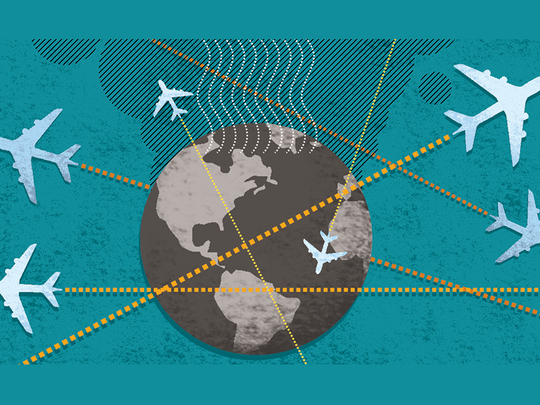
Summer is travel season. Most flights are already fully booked; many airlines have rented additional aircraft to deal with hordes of travellers wanting seats; airports are teeming with passengers. In July and August, more than five million planes will take off — that is more than 80,000 flights each day, more than 30 million this year. Last year, 3.1 billion passengers took flights somewhere on earth.
A recent survey found that one in four air travellers were highly stressed by air planes. The impact of flights on our environments, however, is not much of a concern for people. We rarely think about the pollution and greenhouse gases that aircraft release into the atmosphere — a major problem, as I will explain.
Indeed, it is expected that by 2020, the 30 million flights a year will have multiplied to 200 million. The aviation industry needs to produce five aircraft each day, or close to 10,000 new ones within five years, to meet the huge current market demand.
Air planes currently produce 2.5 per cent of all the carbon dioxide (CO2) that humanity releases into the atmosphere through various forms of activity. That may not seem like much, but it is 12 per cent of all transportation vehicles, including all cars, buses and trains. Each traveller in effect produces 140 grammes of CO2 per kilometre. Car passengers produce about 100g per kilometre, roughly (depending on the average number of persons per car, the type of fuel used etc). Put even more strikingly, each kilo of fuel that an air plane consumes releases 3kg of CO2.
To be fair to the aviation industry, one must note that significant improvements have been made in aircraft technology to reduce the effects of emission. In the past 50 years, air pollution per passenger has been reduced by 75 per cent, two thirds of that just in the last 15 years. But with the exponential increase in air traffic in recent years, the net atmospheric impact has been worsening, and rather fast: Production of greenhouse gas emissions by aircraft has increased 83 per cent worldwide between 1990 and 2012. Another factor weighing negatively on the problem is the ageing of planes — with older ones being much less fuel-efficient and “clean” as lower-grade airlines are unable to renew their fleet over short time-spans.
CO2 is not the only bad product of air traffic. Fuel burning also produces NOx (Nitrogen Oxides) gases, which are not only bad for the environment (they react chemically to produce Ozone, which is a greenhouse gas), but also pose hazards. Aircraft engines also release water vapour, which can be seen as condensation trails (“contrails”) high in the sky behind air planes, as the water vapour condenses and freezes around small aerosol particles that are produced in the aircraft’s exhaust.
But while international regulations on aircraft contributing to pollution and production of greenhouse gases are rather limited and weak, airlines and airports have been making notable efforts lately. In the international aeronautics exposition that just ended in Paris, some airlines have promised to reduce CO2 emissions per passenger by 20 per cent within the next six years, mainly by using cleaner fuels that are currently under development or in trials. Eyeing the world summit on climate change that will be held this December in Paris, International Air Transport Association has set ambitious worldwide goals: Stopping the increase in aircraft production of greenhouse gases by 2020 and reducing them by 50 per cent over the next 30 years (compared to the 2005 levels). This will not be easy, considering that the number of air travellers will probably triple, perhaps more, within a few decades. Yet, these are good objectives no doubt. Indeed, if we keep the same trends, there is no way we can meet the goal of keeping the global rise in the Earth’s temperature to 1 to 2 degrees Celsius by the end of this century.
What then can and should be done?
First, we must invest in technological solutions that can improve the efficiency of engines, aircraft aerodynamics, weights of materials and other technical aspects of aircraft. The aviation industry is also currently working hard to increase the usage of fuel alternatives, those based on biomass (e.g. “biokerosene”). Two years ago, Airbus signed a big contract with China Petroleum and Chemical Corporation to develop an entire refinery to produce fuel based on biomass. One is currently being built near Shanghai and it will be highly interesting to see what and how much it can produce.
Some NGOs are clamouring for a “CO2 tax”, to make air (and other) industries pay a price for the (negative) environmental impact they make. Those NGOs have seen the fall in oil prices as the best time to introduce such a tax, as airlines (and ticket buyers) will not be affected so much.
And last but not the least, environment protection agencies have been trying to educate the public on the importance of using more environment-friendly transportation means. Indeed, as I mentioned earlier, a trip by car produces 40 per cent less CO2 over the same distance, compared to a plane. Much better still, a train produces four to five times less, while a bus two to three times. Perhaps one of the best solutions is to develop fast, long-distance trains. At least that way, we will learn to live more slowly and enjoy beautiful landscapes.
Nidhal Guessoum is a professor of Physics and Astronomy at the American University of Sharjah. You can follow him on Twitter at: www.twitter.com/@NidhalGuessoum.









